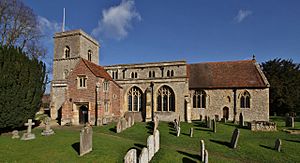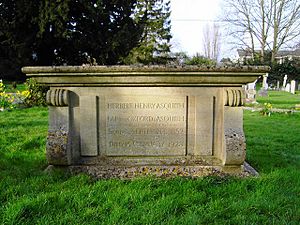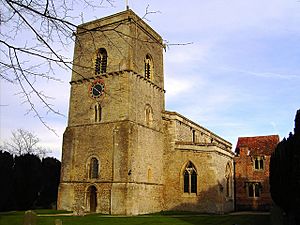All Saints' Church, Sutton Courtenay facts for kids
Quick facts for kids Church of All Saints |
|
|---|---|

All Saints' church from the south
|
|
| Location | Sutton Courtenay |
| Country | United Kingdom |
| Denomination | Church of England |
| Website | All Saints' Sutton Courtenay |
| History | |
| Founded | 12th century |
| Dedication | All Saints |
| Architecture | |
| Heritage designation | Grade I listed |
| Designated | 9 February 1966 |
| Years built | 12th century |
| Specifications | |
| Bells | 8 (Ring) |
| Tenor bell weight | 0 long tons 12 cwt (1,300 lb or 0.6 t) |
| Administration | |
| Parish | Sutton Courtenay |
| Diocese | Oxford |
| Province | Canterbury |
The Church of All Saints is a historic church in Sutton Courtenay, England. It belongs to the Church of England. This church has been around since at least the 1100s. It is a very important building, listed as Grade I listed since 1966. You can find it in the middle of the village, close to the village green.
History of the Church Building
The oldest parts of the church, like the main area (called the nave) and the bottom of the tower, were built in the late Norman period. The font, where baptisms happen, is also Norman. It has cool pointed arches carved into it.
The part of the church where the altar is (the chancel) and the third level of the tower were added in the 1200s. In the 1300s, more parts were built. These include the upper windows (called the clerestory) and the side sections (called aisles). These aisles have four-arch walkways (called arcades).
The clerestory has five windows on each side. Most of these windows are in a style called Perpendicular Gothic. However, two windows on the north side are in an older style called Decorated Gothic. The brick porch on the south side, which has two floors, was built in the early 1500s. The south door is made of oak and has panels, also from that time.
For a while, different groups controlled the church. Sometimes it was Abingdon Abbey, and sometimes it was the Pope. In 1258, the Abbey rented out the church. Later, when Hugh Courtenay became the owner of the land, he took over the church's rights from the Abbey.
Around the tower door, you can see marks carved into the stone. People believe these were made by soldiers who came back from the Crusades. They carved them to thank God for their safe return. The church tower has a special clock with only one hand. There are only 22 such clocks in all of England!
The large screen that separates the nave from the chancel (called the rood screen) was built in the 1400s. Above the arch leading to the chancel, there is a painting of the Stuart royal coat of arms.
In 1643, during the English Civil War, gunpowder and weapons stored in the church exploded. This blast broke windows and damaged part of the tower. The King's coat of arms painting was likely added after the king was put back on the throne in 1660.
One of the church's wooden seats (a pew) has the date 1633 carved on it. The six-sided stand where the preacher speaks (the pulpit) is from the Jacobean period. It was given to the church in 1901.
Church Bells
The church tower has a set of eight bells that can be rung together. This is called a ring. The bells vary in weight, with the heaviest one weighing about 12 hundredweight. They are all tuned to the musical key of F major.
Some of the bells are very old. Two of them were made in 1675 by Richard Keene. Another bell was made in 1775 by Thomas Swain. Robert II Wells made a bell in 1787. In 1829, Robert Taylor made the fifth bell. The largest bell was remade in 1965 by Mears and Stainbank. Until 1986, there were only six bells. The two newest bells were made in 1986 by the Whitechapel Bell Foundry.
Church Records
The church keeps important records of events like christenings, marriages, and burials. These records go all the way back to 1538–39. You can find these old parish registers at the Berkshire Record Office in Reading.
Churchyard and Notable Burials
The churchyard is the area around the church where people are buried. About 33 feet south of the chancel, there is a stone tomb from the 1400s. It is decorated with a pattern called quatrefoil. This tomb is also a listed building, rated as Grade II*. Another interesting tomb is about 49 feet east of the chancel. It was built in the 1700s for Thomas Dalby, who passed away in 1734.

Many famous people are buried in this churchyard. These include H. H. Asquith, who was the Prime Minister of the UK from 1906 to 1916. His second wife, Margot Asquith, is also buried there. Other notable people include newspaper owner David Astor and the famous writer George Orwell. Orwell's real name was Eric Arthur Blair.
The writer Bill Bryson visited this graveyard. In his book Notes from a Small Island, he wrote about how amazing it was to find the graves of "two men of global stature" in one small village churchyard.
H. H. Asquith passed away in 1928. He is buried in a large stone tomb south of the chancel. He wanted to be buried in Sutton Courtenay instead of Westminster Abbey. His burial was a simple church service. Margot Asquith was buried with him in 1945.
George Orwell is buried in a simple grave that now has a red rose bush growing on it. Orwell did not have a direct connection to Sutton Courtenay. However, he was a friend of David Astor. Astor arranged for Orwell to be buried in the village. This was because Orwell had asked to be buried "according to the rites of the Church of England, in the nearest convenient cemetery." His body was brought from London and buried on January 26, 1950.


